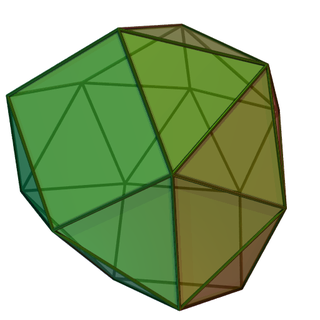Top Qs
Timeline
Chat
Perspective
Disphenocingulum
90th Johnson solid (22 faces) From Wikipedia, the free encyclopedia
Remove ads
In geometry, the disphenocingulum is a Johnson solid with 20 equilateral triangles and 4 squares as its faces.

Properties
The disphenocingulum is named by Johnson (1966). The prefix dispheno- refers to two wedgelike complexes, each formed by two adjacent lunes—a figure of two equilateral triangles at the opposite sides of a square. The suffix -cingulum, literally 'belt', refers to a band of 12 triangles joining the two wedges.[1] The resulting polyhedron has 20 equilateral triangles and 4 squares, making 24 faces.[2]. All of the faces are regular, categorizing the disphenocingulum as a Johnson solid—a convex polyhedron in which all of its faces are regular polygon—enumerated as 90th Johnson solid .[3]. It is an elementary polyhedron, meaning that it cannot be separated by a plane into two small regular-faced polyhedra.[4]
The surface area of a disphenocingulum with edge length can be determined by adding all of its faces, the area of 20 equilateral triangles and 4 squares , and its volume is .[2]
Remove ads
Cartesian coordinates
Let be the second smallest positive root of the polynomial and and . Then, the Cartesian coordinates of a disphenocingulum with edge length 2 are given by the union of the orbits of the points under the action of the group generated by reflections about the xz-plane and the yz-plane.[5]
Remove ads
References
External links
Wikiwand - on
Seamless Wikipedia browsing. On steroids.
Remove ads











